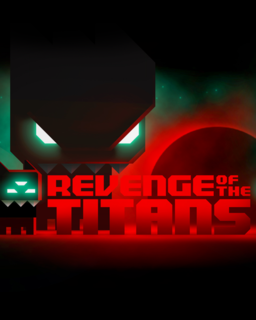INTRO:
Before this game, indie game-maker Puppy Games had been making little more than arcade titles which emphasizes quick-thinking and reflexes.
With Revenge of the Titans, Puppy Games wants to create gameplay which rewards strategic thinking – and quick-thinking and reflexes.
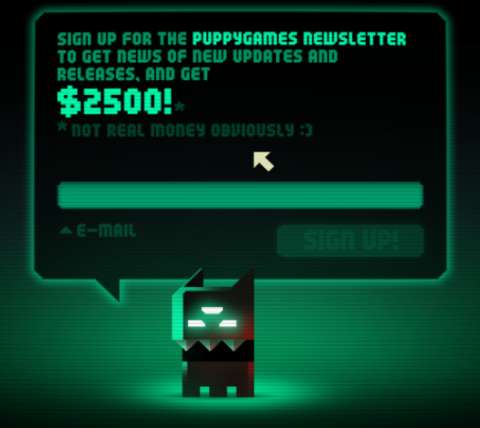
It is an odd goal, but it is one which created a rather peculiar game. Revenge of the Titans has many small flaws, especially in its presentation (as to be expected of a Puppy Games title), but like its predecessors, it offered frantic fun, with tactical shenanigans on top of this.
PREMISE:
Although it does not make a clear reference to Titan Attacks (which is an earlier Puppy Games title), Revenge of the Titans is supposedly about the second invasion attempt by the alien civilization which resided on Jupiter’s moon, Titan.
However, instead of attacking Earth and its holdings in the Solar system with waves of flying ships, the aliens have decided to go with ground battles instead. Specifically, they do these with enormous monsters known as, unsurprisingly, Titans.
It is not known for sure how they could ship so many monsters all over the Solar system, but the aliens did just that, quickly overwhelming the humans who did not expect such kind of warfare.
Yet, learn the humans will, and soon enough, they are on the counter-offensive, making use of massive turrets which can obliterate even the immense monsters.
SUPPOSEDLY TOWER DEFENCE:
Revenge of the Titans has been described as a tower defence title. At first glance, this description seems true.
The aliens enter the map in waves and convoys, heading towards the player’s field HQ to wreck it. The player must stop them, usually by building turrets close to the paths which they take so as to shoot them as they pass by. This is, of course, “tower defense 101”.
However, there are so many nuances to the gameplay that any player who thinks that this is just another tower defence game would be surprised in rather unpleasant ways. These nuances will be described later.
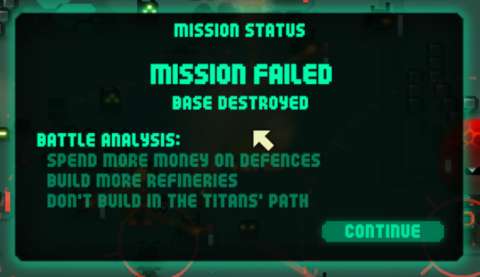
There are five game modes: Campaign, an easier variant of Campaign, Endless, Survival and Sandbox. Among these, Campaign mode is the one which the new player should start with, because it comes with many important lessons.
PLACING ASSETS:
Much of what the player would be doing in any level is placing down stuff. With the game being supposedly a tower defence title, a veteran of the genre might expect the game to give the player a certain amount of money to place down said stuff, as well as the time to do so. Indeed, the game, or at least its Endless and Campaign modes, do just that.
In the case of most other tower defence titles, the player is often punished for not placing defences in such a manner as to counter the wave of enemies which would come; the player usually can only correct himself/herself after failing for a few times and learning by trial and error.
Revenge of the Titans, on the other hand, gives the player many opportunities to do something when the unexpected happens. In fact, the unexpected happens almost all the time due to other nuances which have yet to be mentioned, and the player would be frantically placing stuff all over the place to stall and hurt the Titans as much as possible.
Moreover, the player might even learn some amusing things about the game while frantically placing stuff. One of these is that the player can kill Titans by placing turrets on top of them.
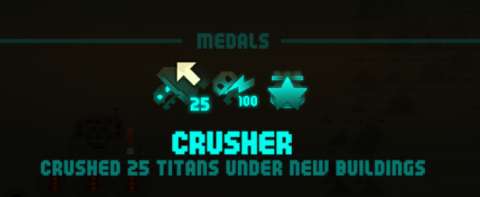
(This crazy tactic will damage the turrets though.)
TURRETS:
Speaking of turrets, these are the player’s main means of getting rid of Titans.
At first, all the player has is the most basic of turrets: the Blaster. This is one of the few cheap buildings which the player can have, but at $250, it is still too considerable a price for the player to place it willy-nilly.
To obtain more types of turrets to build, the player must delve into the game’s system for “research”, which will be described later. For now, it can be said that placing other turrets is similar to placing the Blaster; the player mainly needs to have the money and space to place them.
However, there are three types of (particularly powerful) turrets which are what the game considers “limited in production”. There will be more elaboration on this later because it affects many other kinds of assets, but it should suffice to say for now that money and space are not the only limitations to placing them. This is for understandable reasons of gameplay balance, of course.
When considering the placement of turrets, the player needs to think of the reach of their weapons. Fortunately, there are visual indicators for range in the form of circles which are centred on the turrets.
Generally, all turrets shoot at the first thing which enters into their range. However, certain turrets, especially those with area-effect attacks, have additional A.I. scripting which are interesting enough to warrant a section of its own within this review.
(SOMEHOW) SMART TARGETING:
Turrets which fire off single shots generally shoot at the weakest Titan in range, if there is more than one Titan which they can shoot at. However, if there are other turrets within range, they appear to have A.I. scripts which make them distribute their shots more efficiently when there are multiple targets to deal with.
For example, the player may notice that where there are clusters of Blasters and Heavy Blasters facing unarmored Titans, the Heavy Blasters hold their shots for healthier and tougher targets which are within range while letting the Blasters remove the almost-dead ones.
On the other hand, the player might not want to see this kind of targeting too often, because it would mean that the Titans have managed to bunch up and the player faces the risk of the Titans outright overwhelming the player’s turrets.
In other words, the player is better off trying to goad and lure the Titans into coming piecemeal into his/her defences.
However, when this happens, the player may notice that a cluster of turrets do not efficiently manage their shots against lone Titans; they immediately fire at the first Titan to come into their range, possibly wasting their shots by causing overkill.
Turrets which do not fire single shots have very different scripts. These scripts do not consider other turrets in range, but instead considers when and where to fire off their shots for best effect.
This can be seen in how Missile Turrets launch their precious few rockets. If there are multiple enemies within range and that they are bunched up, the turrets fire at the enemy in the middle of the bunch, or if they are too dispersed, fire on empty terrain so that they are caught in the blast anyway.
Another example is the Laser Turret, which angles its beam so that it hits multiple targets in its range.
However, these turrets still have the same tendency as other turrets to fire at the first enemy which comes within range.
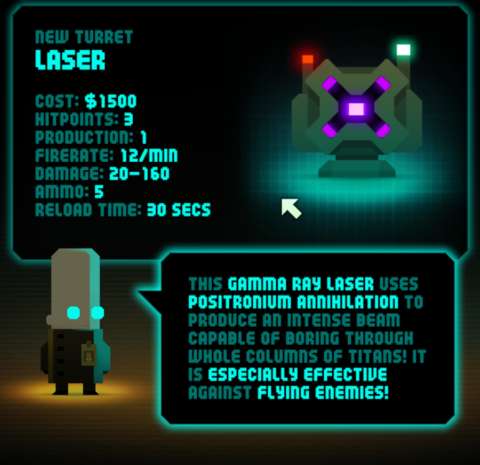
STRAY SHOTS & DEFLECTIONS:
There will be moments when turrets have their shots seemingly landing ineffective shots, or they miss entirely. Generally, the player might want to minimize these occurrences by placing turrets where they get the most convenient field of fire and that turrets have the necessary penetration rating to overcome the “armor” which the Titans have. (There will be more elaboration on “armor” later.)
The Turrets generally fire fast-moving projectiles, but there are times when the Titans are moving so fast that they can dodge them. These shots are not completely wasted, however; they may travel for quite a distance before disappearing, or they might just hit something along the way – including the player’s own buildings, if the player had not considered the possibilities of deadly cross-fire.
On the other hand, if all the stray shots would encounter are Titans, then they hit and damage those Titans anyway.
There are Titans with considerable amounts of “armor”, which is actually natural field-based shielding, if one is to be all nerdy about sci-fi matters.
If a Titan has enough “armor” to reduce the damage of a shot but not negate it entirely, it takes the shot and absorbs it; the shot ends there. However, for Titans which are much tougher, the shot bounces off completely – and might hit another Titan instead, but for much reduced damage.
These minor gameplay elements are interesting, but the player should not depend on them to actually win.
It is worth noting here that the rockets fired by the Missile Turret will neither ricochet off Titans nor miss – the Missile Turret decides where its rockets would travel to and detonate. However, the Missile Turret is severely stymied by a few shortcomings which will be elaborated later.
The Laser Turret’s beam can also be deflected, but the damage which the Titan has reduced via its armor is not completely lost; instead, it is present in the deflected beam, which can hit another Titan. (The Laser Turret’s beam appears to pass through other buildings, so there is no risk of friendly fire from Laser Turrets; the same which could not be said about the Missile Turrets.)
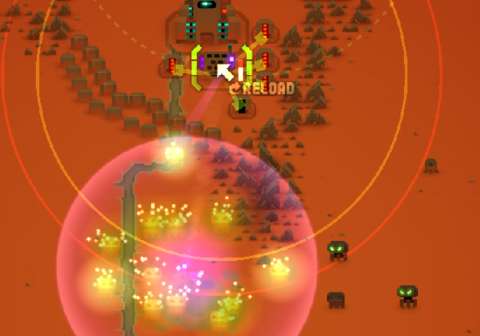
AMMUNITION:
All turrets have unlimited reserves of ammunition, but limited magazine sizes. Generally, the more powerful a turret is, the smaller its magazine is. Furthermore, bigger magazines – and bigger guns - generally take longer to reload.
These limitations are of course intended as balances for more powerful turrets.
Most turrets can be manually reloaded simply by clicking on them. However, regardless of the number of shots left in the magazine, the reloading time is the same. Considering that all it takes to manually reload a turret is to click on it, accidental clicks can be costly.
There are ways to speed up reloading processes, such as placing reload add-ons (more on add-ons later) and reload power-ups (more on this later too). However, the quickest way to “reload” a turret is to sell it and replace it. It is a costly tactic, but there is nothing else to stop the player from doing this.
MINES & WALLS:
The Titans have to scamper towards the player’s HQ to destroy it. Therefore, the player has access to (self-explanatory) mines and walls to stymie them.
However, the Titans are not completely stupid. Although the Titans cannot see mines, if too many of them had been stepping over a stretch of mines, the ones behind them actually take a different path – which the player could riddle with mines, of course (but there is a limitation to that, as will be described later).
The only exception to such behaviour is roads; the Titans almost always pick roads over other paths (for a good reason which will be described later), so mining the roads is usually an effective tactic.
Mines can hit multiple Titans if they are caught within the blast; this is a fact which can be exploited during the Titans’ onslaught by putting mines right in the midst of them.
There are only three types of mines, but each is different from the others. Among the three, the Blast Mine is the oddest one because it has to be manually armed.
Walls are objects which the player places in the way of the Titans. They are far from contiguous structures, and actually resemble tank-traps more than they do actual walls.
Since the Titans will not stop biting something once they have come close enough to deliver bites, walls allow the player to take advantage of their behaviour.
However, incoming Titans will avoid walls if there are Titans already attacking them. They skirt around their compatriots and attack other sections of a line of walls. If the Titans have managed to make a breach, they will flow through the breach; occasionally, some of them would chew on the blocks adjacent to the breach, thus widening it.
There is not much in the way of variety among the walls. Generally, more expensive walls are tougher.
There is an important limitation about walls and mines: they cannot be sold after having been placed. This might seem trivial, but mines and walls are considered “limited-production” assets.
ASSETS WITH LIMITED PRODUCTION:
Generally, if the player has the money to place an asset, he/she can do so. However, certain assets are considered as “limited in supply”.
To elaborate, within any level, the player can only place limited amounts of these assets, regardless of whether the player has the money to purchase more or not. The supplies for these assets are replenished after every level in Campaign or Endless mode, but are otherwise finite.
This limitation is applied on the more strategically useful of assets, such as mines, walls and particularly powerful turrets. Indeed, the astute and clever player might just realize that these assets are more effective at stalling and killing the Titans than any other assets. Therefore, this limitation is perhaps understandable.
The player can attempt to hoard supplies for these assets, but there are hard limits on how much can be hoarded too. This is perhaps a wise game design, because it encourages the player to use them in every level anyway.
EXPLOSIVE MUNITIONS:
Having mentioned missile turrets, mines and smart-bombs, it has to be said here that these are metaphorical double-edge swords. Understandably, when these things go boom, they might damage any of the player’s assets which happen to be caught in the blast.
Incidentally, there have been a considerable number of changes concerning these explosive tools, brought by updates to the game. At this time of writing, there are special scripts for explosive munitions.
Firstly, explosive damage does not affect walls whatsoever. This is odd, because there are Titans with explosive attacks which are meant to be used against walls. However, this discrepancy does appear to make mines compatible with walls (which is indeed an effective and potent combination).
Secondly, speaking of mines, they do not damage each other, whether they are of the same type of mines or different ones. Mines also appear to do reduced damage to buildings, which in turn encourage the player to use mines more liberally. Smart-bombs also do not damage mines and though they do inflict damage on buildings, it is not too severe.
(For best effect, the player might want consider taking research options which increase the “armor” of buildings.)
Thirdly, none of the advantages which mines have are available to Missile Turrets. Among the player’s explosive assets, Missile Turrets are the riskiest. A missile turret cannot destroy itself with its own rockets, but it blows up anything else, Titan or building. Indeed, it can be very easy to make the mistake of misgauging where to place the Missile Turret, with the most embarrassing of consequences being that it blows up the field HQ.
The last nuance about explosive munitions is that they ignore armor completely, thus making them terrifically effective against armored Titans. This was perhaps intended to counter-balance the risks of using explosives.
CAPACITORS:
Capacitors are special turrets which work quite differently from other turrets.
Firstly, these turrets are not automated at all. Instead, they are under the control of the player. This might seem to make capacitors more desirable than other turrets (whose A.I. is not exactly very clever), but controlling capacitors while monitoring the Titans’ onslaught is no easy task.
Secondly, the capacitors discharge lightning bolts which completely ignore the armor of Titans and also stun them for as long as they are being zapped. This makes them very handy for stopping boss Titans.
Thirdly, since capacitors are controlled by the player, they are some of the very few assets which can stop certain particularly troublesome Titans (which the game will inform the player about).
Finally, capacitors do not follow the usual system for ammunition. Instead, they recharge over time and can fire as long as they have charge left. On the other hand, this convenience is counter-balanced by how fast capacitors can drain their charge away.
If there is a significant issue with capacitors, it is the system which the game uses to allow the player to fire capacitors.
To control them, the player only needs to bring the cursor closer to the capacitors. White rings appear around the capacitors indicating their reach, and the player can make them fire at anything within reach simply by making mouse-clicks within the rings. The player can also hold the mouse button down to have them fire continuously.
This may seem intuitive and convenient at first glance, but in practice, the rings can overlap a lot when the player has the capacitors clustered together (as is likely, because capacitors are a lot more useful when bunched up). The overlapping rings can make targeting quite difficult, because they can obscure the player’s intended target and complicate the gauging of the capacitors’ ranges.
Using capacitors also reveals design oversights in the hit-boxes of the Titans. Generally, attacks have to be directed at what passes for their feet; the A.I.-scripting for automated turrets are aware of this, but the player might be having capacitors shoot at what appears to be their bodies yet they are actually only hitting the ground to the north of the Titans. This can happen in the case of particularly large Titans.
ADD-ONS:
There are more buildings than just turrets. Among these other buildings, the ones which the player is more likely to build than the rest are what the game calls “add-ons”.
These are generally smaller than turrets, which is just as well because the player will need to cram as many of them near turrets as possible for them to be effective. Add-ons are also cheaper than turrets, though not by much; this was in order to, ironically, prevent the player from cramming too many of them near turrets such that the latter become overpowered.
Add-ons grant bonuses to the statistics of turrets within their range of effect. Generally, each type of effect is associated with one type of add-on. For example, the Battery add-on increases the magazine size of the turret which it is supporting, but without changing reloading times.
Perhaps the most interesting – yet most confusing – add-on is the Reactor. On paper, it supposedly improves the damage of turrets which it is supporting. However, when it is used together with certain turrets, those turrets gain something else other than damage bonuses. For example, the Reactor, when coupled with the Capacitor, increases the latter’s range.
These differences are not well-documented in-game, and the game does not inform the new player about them. To learn more about the Reactor and its effects, the player may need to use the official Wiki of the game.
Depending on the scenario, certain add-ons may be more useful than most others. For example, there are many scenarios where Battery add-ons would suffice; in these scenarios, the deluge of Titans would be so dense that maintaining a wall of fire without down-times for reloading is a more important consideration than anything else.
Conveniently, all add-ons have the same range with which they apply their effects. Coupled with their generally similar sizes (the Reactor being the exception), the player can sell off existing add-ons which are supporting turrets and replace them with some other without having to worry that they might not be within range.
Furthermore, more than one turret can share the same add-on, if both are within the add-on’s range of effect. In fact, there is no artificially imposed limit to how many turrets which an add-on can support.
SHIELDS OF BUILDINGS:
The hitpoint system for buildings is called “shields” in-game. To followers of Puppy Games’ titles, this is of course just a continuation of its tradition of an alternative name for “hitpoints”.
However, the shields in this game are very much unlike the shields seen in earlier games. Instead of just being a measure of the damage which something has taken before it is considered destroyed, they have a secondary function of retaliating against close-combat attackers.
When a building is attacked by the Titans, it of course loses hitpoints. However, if the damage was inflicted through bites – and Titans love to bite away at things – some of the Titan’s own damage output is duplicated and reflected back at it when it bit the building.
This means that the player can attempt to use buildings to stall and destroy waves of Titans. This tactic is especially handy if the player can place refineries (more on refineries later) in the way of the Titans. As self-defeating as this may seem, refineries are cheap and large buildings, which make them very handy sacrificial assets for players who have no issue with cavalier strategies.
Lost shields can be restored by using repair power-ups, or by investing research points into repair droids. However, research power-ups are scarce commodities, and repair droids make their own decisions, out of control of the player.
Interestingly, walls do not benefit from the same system of shields; if a wall block is damaged, it is damaged permanently, and will not damage the Titan which is chewing away at it.
MONEY & CRYSTALS:
Unlike most other tower defence titles, the money which the player needs to place buildings are not obtained from killing whatever threatens the player. Money is not granted by prevailing through scenarios either.
There are certain research options which can provide grants of money. However, these are just one-off contributions and will not be enough for the player’s use.
The player can also gain money from achieving certain feats, such as not having a single building being damaged (which is a feat indeed). However, these rewards tend to be so small as to be inconsequential; only particularly tough feats grant considerable money rewards, and getting these feats may require the player to spend more than what would be gained anyway.
Instead, most of the player’s money comes from harvesting materials from crystals which are found throughout the levels which are seen in the game.
The presence of these crystals is not well-explained in the story, but otherwise, they are needed in order to fund the player’s war efforts.
These crystals appear as obstacles on the battlefield. A counter shows how many crystal formations there are in a level. A hotkey is dedicated to finding formations which are not being mined.
Crystals prevent the player from building assets on or near them, and also prevent the Titans from moving through them. The only way to remove them is to mine them, which will be described later.
Even as crystals appear to reduce in size due to being mined, they still occupy the same space; this is not told to the player. However, when a crystal is exhausted, it disappears suddenly; the only warning which the player has is the crystal counter reducing by one point.
Therefore, the player might want to exercise some caution when using crystal formations as part of defensive lines while having the intention to mine them. Exhausting formations during the Titans’ onslaught can result in very unpleasant setbacks.
There is another element of the game which concerns how crystals and money affects the difficulty of the game’s levels. This will be elaborated later in its own section.
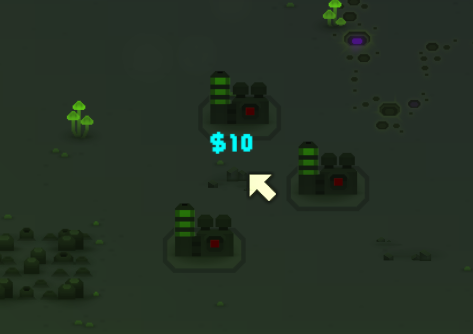
MINING CRYSTALS:
Mining crystals is generally a simple matter: the player merely places refineries close to the crystal formations and the refineries would start firing rays at the formations to break them down and retrieve whatever has been released.
However, refineries can only be deployed near crystals as long as the crystals are within range of the rays of the refineries. This means that if there are no more crystals in the map, the player cannot place any more refineries. This also means that there can only be so many refineries which can be placed around crystals, and refineries are rather large structures.
Coupled with the options to place add-ons which specifically improve refineries, trying to cram as many refineries around crystals as possible can be quite a challenge.
Incidentally, some crystal formations are in the way of the Titans’ onslaught; this almost always occurs in just about every scenario.
However, this is not always a problem. If the player has a lot of money to spare, he/she can attempt to use refineries to stall the Titans in the manner which has been mentioned earlier.
There is a gameplay issue concerning refineries though. Although the game does provide visual indicators of which crystal formations are in range of the refineries, the player has no way to control which crystal formation a refinery will target first.
This is not always an issue, but if the player would rather want specific crystal formations removed before others, this can be one.
The mining of crystals is also tied to how the Titan onslaught is triggered. In most game modes except Endless, as soon as the player has placed the first refinery, the Titans will come. There is another way to trigger the Titan onslaught, as will be mentioned later.
This is not exactly mentioned in-game; instead, the player must look at the game’s official how-to-play guide on Puppy Games’ website for this.
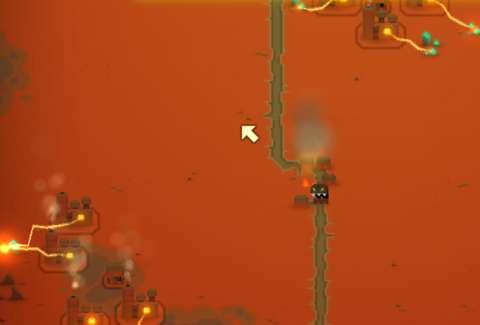
SELLING ASSETS:
The purchase cost for a building which has been placed can be partially recouped by “selling” it.
When a building is “sold”, the player gets a small amount of its cost back; this is usually less than 50% of the building’s price. If the building is already damaged, the recouped money is even less. In fact, if the building is already halfway to destruction, nothing is returned.
Selling assets is not as immediate as placing them. When a building is sold, it unceremoniously blows up, as things are wont to in a Puppy Games’ title. The player will need to wait for the animation to end before the building frees up the space which it previously occupied.
POWER-UPS:
Puppy Games will never allow any of its games to lack power-ups, apparently.
In Revenge of the Titans, these power-ups appear as icons which spawn onto the battlefield, hopping in place and making wobbling noises to attract the player’s attention. Indeed, the player should take heed, because some of these power-ups can be crucial to a battle, and that power-ups disappear after a short while (as they are wont to do in Puppy Games titles).
The most common of these power-ups are cash prizes. The amounts which they reward are actually quite paltry; there is barely enough for a Blaster or two, unless the player can be lucky enough to get many of them spawning, though this would mean that the player would not be able to get the other kinds of power-ups.
These other power-ups are much more useful. These include the Berserk power-up, which followers of Puppy Games might just recognize. In this game, it completely reloads the magazines of all turrets in the battlefield, and as long as its (short) duration lasts, they do not consume any ammo at all. They also have improved rates of fire and higher damage output.
This makes Berserk incredibly useful for particularly hairy situations, e.g. for dealing with a boss Titan before it gets too close to the player’s field HQ. It is even more useful if used together with Freeze, which is another power-up which immobilizes all Titans on the battlefield while it lasts.
Another familiar power-up is the Smartbomb. As its name suggests, it is an immediately deployable explosive, which certainly comes in useful for dealing with deluges of Titans.
Super-shields are supposed to grant temporarily invincibility to all of the player’s battlefield assets. However, the game does not inform the player that super-shielding does absolutely nothing to stop boss Titans; there will be more elaboration on this later.
Perhaps the developers had intended this to be a nuance, but this is more likely to be an unpleasant lesson instead.
For better or worse, one of the few ways to repair buildings is packaged in a power-up. Yet, if one considers that it does repair all buildings to full health immediately, the scarcity of this otherwise reliable method of dispensing repairs is understandable.
Most power-ups have instantaneous or temporary effects, but there are some which last for an entire level. These are called “exotic” power-ups in-game, and appropriately so, because the probabilities of them spawning in place of other power-ups are very, very low.
These power-ups provide bonuses which are similar to those granted by add-ons, but they affect every turret on the map and for the duration of the level.
What the game does not inform the player though is that for these power-ups to spawn, the player must already have unlocked the associated add-ons through the research system before they have any chance for spawning. Instead, the player must check the game’s official wiki to learn this.
Interestingly, unlike their counterparts in previous Puppy Games titles, special power-ups can be stored for later use. In the case of Campaign and Endless modes, they even persist from level to level.
In fact, it is in the player’s interest to hoard them; the game will not inform the player of the need for this. Less experienced players might have to learn the hard and unpleasant way of the need to do something which the game could have advised them to do.
RESEARCH:
As mentioned earlier, humanity was only beginning to understand how to combat the Titans and their unconventional method of warfare (read: mobs of giant teeth and muscle). With the help of coffee-addicted and often nonplussed scientists (called “boffs” by a certain character), the player can unlock new technologies to fight the Titans in the Campaign and Endless modes.
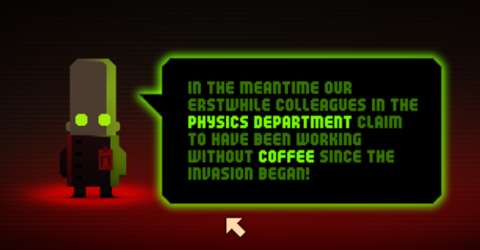
The player starts with only the Blaster unlocked, but the player will need more technologies to survive. To unlock them, the player must complete levels – in the intermission between levels, the player is granted one point to unlock one technology option with.
For better or worse, Puppy Games insists that the player unlock what it considers “basic” technology options before being able to take the “advanced” and “applied” ones. Unfortunately, the “basic” ones do nothing more than fulfill prerequisites.
This is an old practice in designing technology trees, one that should have been left in the past in this reviewer’s opinion.
Anyway, the player has to plan the unlocking of successive inter-associated technologies in order to get to the ones which the player wants. The user interface for the research screen does provide the player with visual indicators for the prerequisites, but the icons for the prerequisites lack tool-tips.
Therefore, the player has to look through the chart of research options for the same icons, which can be a visual problem, as will be elaborated later.
A worse problem though is the lack of descriptions of what unpicked research options do. The player only receives information on what they do just after having picked them for the first time around (or after having picked them long after he/she has re-specified research; more on this later). An in-game cutscene pops up to show a scientist mumbling away what the technology option does, together with a listing of the option’s statistics.
After having picked a technology option, the player can look at it again to be reminded about some, but not all, of the information about it. For example, the armour piercing rating of turrets is missing from these reminders.
Interestingly, Puppy Games has provided the convenience of resetting the technology chart. This refunds almost all research points which has been spent thus far – except those which has been spent on one-off research options, such as those which grant the player an injection of money.
This exception is not told to the player, unfortunately. The player might just find that he/she is off by a few points towards unlocking a desired technology option and could not gain them because these one-off options cannot be rescinded.
DROIDS:
Droids are another category of assets which the player can use against the Titans. Unfortunately, they are the least reliable among the player’s means of stopping the Titans.
There are factories which produce droids for free; the player only needs to have the space and money to build them. In the case of regular and tank droids, these seek out Titans to destroy, whereas repair droids seek out damaged buildings to repair their shields.
That they are automatically produced for free appears to be the reasoning for the appearance of factories in the battlefield to be the other immediate trigger for the Titans’ onslaught in the Campaign and Endless modes.
However, in practice, the droids are not worth the trouble of setting up factories. This is because the droids are not completely under the control of the player; they seek out their own targets, and they can be destroyed if the player uses explosive munitions near them. They are also impractical if the player is facing a massive deluge of Titans because they are not spawned quickly enough to counter that.
Droids could have benefited from more advantages, but at this time of writing, they are not as cost-effective as other means of stopping the Titans.
TITANS – OVERVIEW:
The Titans are monsters who love to bite down on anything human – fleshy or otherwise. They will not stop biting away at something until it is destroyed.
The early-game Titans are relatively weak compared to the ones which appear later. The later ones have far higher hitpoint counts and also “armor” to reduce incoming damage.
Most Titans generally attempt to follow the quickest route to the player’s field HQ, even if it is longer than a direct route. However, they also avoid paths on which previous Titans have died, thus requiring the player to consider all possible paths which they would take and rig them with defences.
The later ones, however, have different behaviours. For example, there are Titans which go towards the nearest building to thrash it.
All of the aforementioned designs for Titans are mentioned in-game through text-based hints, which is convenient.
Overall, most of the Titans can be defeated by knowing that they always try to destroy any of the player’s buildings which are in their way; this is a behaviour which can be exploited to stall them and goad them into expending and wasting any one-shot or irreversible abilities which they have.
However, there are a few nuances about Titans which are worth mentioning, mainly because they are entertaining or they have issues.
For the Campaign and Endless modes, the onslaught of the Titans is finite in volume, even if it may seem intense. This is depicted via a counter on the right hand side of the screen; a red bar shortens itself as more and more Titans are spawned into the battlefield. When the bar disappears, no more Titans are spawned for that level, but as a catch, the remaining ones appear to become slightly faster and stronger; this is an interesting nuance.
INTEL ON TITANS:
The game does provide intelligence on Titans, but how timely it is in doing so is rather sketchy.
When it is timely at doing so, it shows an in-game cutscene of a character describing the behaviour of a soon-to-be-encountered Titan and how to defeat it, along with its statistics.
When it is not, the player only gets the cutscene in the intermission after the player has encountered a never-seen-before Titan – likely after having learned a hard lesson in countering said Titan.
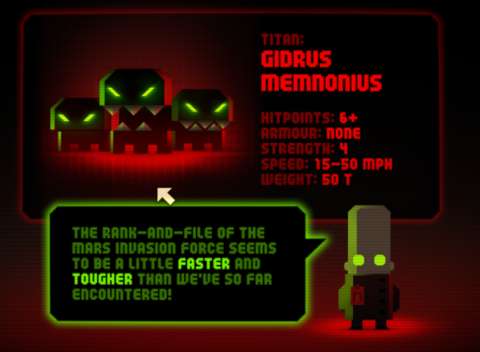
TITAN MOVEMENT:
Most Titans trudge along on their three or more feet, following noticeable paths.
However, the game introduces Titans with more staccato movement later. These make their way towards their target in intermittent bursts of speed, appearing to take a breather in between. These have much less predictable movement, and they may even arc around walls when the player least expects them to.
Finally, the game introduces flight-capable Titans, late into the game. They are also all armed with either blasters or bombs, to compensate for their lack of any biting attack. These can fly over all obstacles and always have clear lines of fire towards whatever they want destroyed.
What the game does not mention about them, however, is that unlike ground-pounding Titans, they cannot change their direction of movement. They appear at the edges of the map, following straight lines which pass over the field HQ and end at the opposite edges. With the exception of one particular flying Titan, they do not linger around to destroy the field HQ.
Most ground-pounding Titans cannot move through walls, which they have to break down before they can continue on their merry way. However, there are Titans which can move past walls, either due to their being small enough to go through the gaps between the blocks or their having otherworldly capabilities.
Incidentally, these particular Titans cannot be targeted by automated turrets, which can be an unpleasant lesson to learn.
Titans cannot move past each other and each occupies its own space. This can be seen from the very first level which the player would play. Interestingly, the Titans move in such a manner that they appear as rivers, flowing around each other with few hitches.
This also means that tactics which are oriented around blocking the Titans’ paths are not always effective. For one, a short stretch of walls only block the first few Titans which encounters it, while the others behind them simply trudge around the obstacle and their busy compatriots. If the player wants to account for this flow-around, the player must set up long stretches of walls, which can use up supplies of walls quickly.
In fact, the Titans’ A.I.-scripting for movement is the main reason for this game being hardly a typical tower defence game. The player must place new turrets and other assets to deal with unexpected detours which the Titans make.
LEADER TITANS:
Leader-class Titans – often given the species name “Maximus” or “Gigantus” – are one step above the ‘regular’ Titans in just about any aspect. They are also bigger than their regular counterparts, which make them easier to notice.
The most interesting design about these leader-class Titans is that they drop power-ups when they die. These power-ups are a lot shorter-lived than those which spawn randomly though, and more importantly, they lack the visual aid which the other power-ups have.
BOSS TITANS:
Some time into the game, “boss”-class Titans are introduced. They are typically named after mythical gigantic beasts, or else have prefixes like “Mega-“ attached to their names. When they do appear in a level, the player is warned about “Extreme Danger”, which is perhaps a handy reminder that the level would not be as easy as levels which lack boss Titans.
These immense creatures slowly but surely make their way towards the player’s field HQ; if they do, the player is doomed. Therefore, the player must damage them along the way, which is easier said than done, because these Titans have tremendous amounts of hitpoints and more often than not, a lot of armor too.
Eventually, the new player learns that he/she should not be letting them get too close to the field HQ in the first place. Stalling and damaging them while fending off the smaller Titans can be quite stressful, but it is exciting enough to be appreciable.
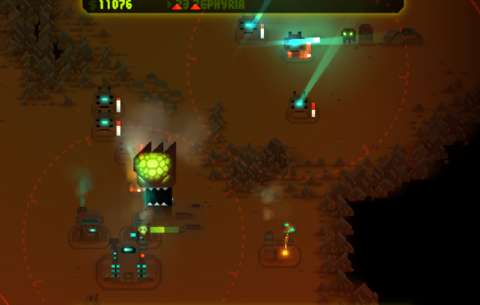
What is not appreciable though is the lack of warning about the boss Titans’ ability to bypass the Super-shield power-up with their powerful bite, which destroys anything outright. Learning this the hard way can be an infuriating experience.
TERRAIN:
The contribution of terrain to gameplay further makes Revenge of the Titans more different than its predecessors. Some terrain features have already been mentioned earlier, such as mountains and roads.
Roads are mainly of use to the Titans; they move a lot faster on roads. Consequently, they are more than likely to pick roads as their preferred paths. This is, of course, a lesson for the player to notice and apply some tower defence basics, namely placing turrets along the Titans’ path, or if the player has more than enough of them, lots of mines.
Mountains and crystal formations block the movement of terrestrial Titans. However, they also happen to block the shots of most turrets, which is a limitation which the game does not inform the player about.
Oddly, the A.I. scripting of turrets does not recognize the presence of mountains and crystal formations when working out their shots. This can result in some unseemly accidents; learning the hard way that mountains and crystals can block the rockets of Missile Turrets can be an infuriating experience.
At the later levels, such as those set on Saturn’s moons, there are terrain features which work in the Titans’ favour. These are mainly pools of glowing liquid, which act as spawn points for the Titans, often placing them nearer to the field HQ than Titans which spawn at the edges of the map.
AUTO-ADJUSTING DIFFICULTY:
Arguably, the most sophisticated gameplay design of Revenge of the Titans is its difficulty system, which is used for its Campaign and Endless modes.
This system alters the amount of crystals and Titans in the next level which the player would attempt. The main factor in the determinations is the amount of money which the player has accrued.
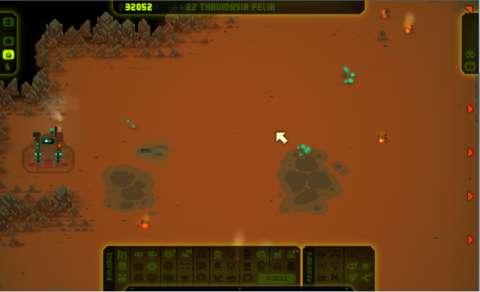
Having more money reduces the amount of crystals in the next level. In fact, if the player has more than 60000 in-game dollars, there will not be any crystals appearing at all. More money also means more Titans appearing in the onslaught, even more than what the level would have by default.
These alterations are intended to challenge particularly skilful and efficient players.
Conversely, a less-skilled player who has not managed to accrue a lot of money will have most of the default amount of crystal available for extraction and fewer Titans to deal with.
The player can turn off this system of course, but both Campaign and Endless modes have their challenges increase gradually as the player progresses anyway. Therefore, being unprepared, i.e. not having enough money for the next level, can result in unsalvageable disaster.
GAME MODES:
There are five game modes, as mentioned earlier.
The Campaign mode is mainly there to teach the player lessons about the game, as well as provide some story of sorts involving a gung-ho general and pillar-headed scientists, as well as the (very simple) motivations of the (otherwise sentient) Titans.
If the player is not very skilful, he/she can opt for an easier version of the Campaign mode. The game can seem remotely condescending about this decision though, such as having medals for players who attempted and succeeded in levels in the default Campaign mode but none for those who played the easier version.
Endless mode is more akin to the gameplay seen in earlier Puppy Games titles; the player plays through sets of levels before the game recycles them, with each level being tougher than the last, regardless. These levels are of course those seen in the Campaign mode. For players who want to experience this game mode, there is the convenience of checkpoints between levels, though they become increasingly rarer and eventually disappear after 250 levels.
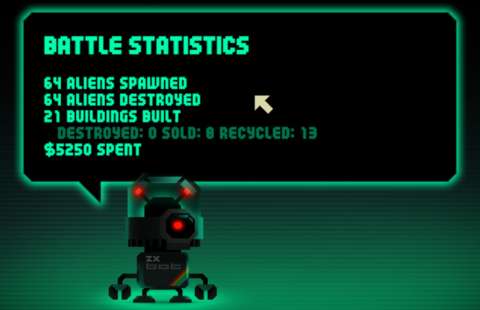
Survival mode throws some gameplay features out the metaphorical window, for better or worse. These include the research system; in its stead, the player is given a fixed set of unlocked technology options, such as a few types of turrets and add-ons, and is expected to prevail against the never-ending and gradually worsening onslaught of Titans for as long as possible. Survival mode also tosses out any conveniences such as preparatory time.
Obviously, Survival mode plays very differently from the other modes, and not in the same spirit either.
Sandbox mode is mainly for ardent fans of the game. To make full use of Sandbox mode, the player must create an account over at Puppy Games’ site before he/she can make use of the browser-based map and scenario editor for the game. The editor is quite easy to use, being mostly point-and-click with a lot of tooltips to describe what a function does.
The player has to log-in in order to design scenarios, but to play the scenarios, the player only needs to launch Sandbox mode, which downloads a list of scenarios from Puppy Games’ servers. However, it has to be said here that the scenario is only as good as the designer is; the user-given ratings that it has give a rough picture of how entertaining it is, but of course, the ratings are ultimately subjective opinions.
VISUAL DESIGNS:
Perhaps in a break from its obsession with neon lighting, Puppy Games seems to have decided that Revenge of the Titans would not be too saturated with such frivolous illumination. This change can be seen in the battlefields on Earth and Mars.
However, Puppy Games’ habit rears its head in the battlefields of Saturn and Titan; there are many glowing pools and craters, especially on Titan. Fortunately, the player can choose to reduce the lighting if he/she finds them too glaring.
There are also other visual options which the player can disable, namely “stroboscopics” and “distortion effects”. Indeed, these, which were in every Puppy Games title before this, are in this one too. Puppy Games just loves them too much to let go of these disorienting visual designs.
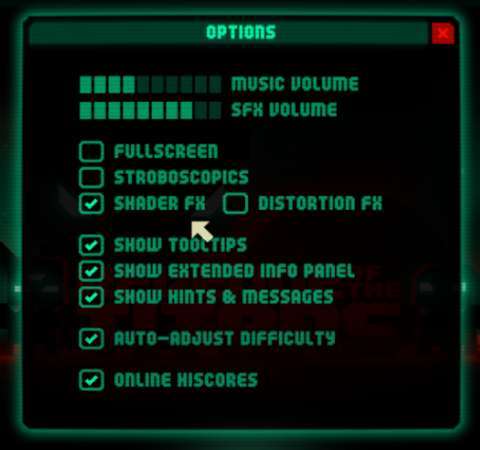
Fortunately, most of the visual designs in the game are to the player’s benefit.
For example, there is the handy visual indicator (in the form of a bar) next to turrets which show the amount of shots left in their magazines. The exact number of shots left is not clear, but such accuracy is generally not needed, even for micro-management.
Another example is that hovering the mouse cursor over a turret shows which add-ons are supporting which turrets, by way of translucent neon green lines connecting the two together.
Yet another is that the crystal counter flashes when there are crystal formations which are not being mined.
As mentioned earlier, power-ups are represented with animated icons which also happen to have their own sound clips. These indicators are apparently not enough; after all, the sprites for the power-ups are small when compared to the rest of the battlefield.
Thankfully, there is an additional visual effect to indicate their presence. A large green ring triangulates onto the position of a power-up, and this ring can be seen quite a distance away from the field HQ.
It has been stated earlier that looking through the chart of research options for prerequisite technologies can be a problem. This is mainly due to the small icons, which do not make for convenient examination and comparison.
As for the aesthetics of the game, this is the first Puppy Games title where humans are actually depicted. However, perhaps expectedly, they are super-deformed and cartoonish-looking. However, the goofiness is balanced by the shading and lighting artwork on their sprites, which make them look quite striking.
The Titans do not make a good first impression though. The first few Titans which the player would encounter are blocky things which more than resemble the Ghosts in old-school Pac-Man.
However, the later ones are much more interesting to look at. They differ in silhouette shapes, body proportions, number of limbs and number of eyes, among others; the only similarity among them is that each of them has a mouth full of big sharp teeth. In fact, their different looks are useful for quickly determining the composition of enemies.
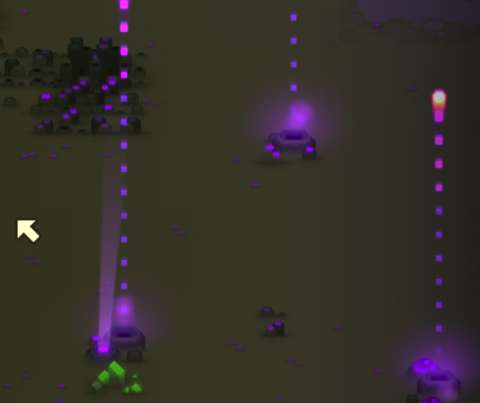
SOUND DESIGNS:
Puppy Games has a history of recycling sound effects for its games, and Revenge of the Titans would not be an exception to the indie developer’s tradition.
Veterans of Puppy Games’ earlier titles may recognize sound effects which are all too familiar. Examples of these are the noises for the weapons-fire of all turrets which the player can build.
There are newer sound effects, such as the distant clang which accompanies the placement of buildings. Unfortunately, some of these are not pleasant to listen to. The worst example is the powering-down noise of the Refinery.
If it was just one Refinery powering-down, the noise would have been quite bearable. Unfortunately, the game plays the sound effect for each Refinery which had powered down simultaneously. This results in very unpleasant amplification.
At the very least, Puppy Games has made certain that almost every sound clip plays a role in the gameplay, though the developer may not have made certain that every sound clip sounds unique to the rest.
For example, there is a sound clip for when there are crystal formations not being mined; it is a series of deep beeps which can be heard above almost anything else. Unfortunately, the same sound clips are also used for when new Titans no longer spawn and the surviving ones become faster (as had been mentioned earlier).
There is music in Revenge of the Titans, but these are mainly heard outside of levels, within the various menus and pre-battle screens. They are mostly electronic tracks, some of which are quite inspiring to listen to, such as the one which plays when the player is looking at the level options for the Earth stage.
Revenge of the Titans is the first Puppy Games’ title to have voice-acting, but if the player is expecting legible lines, he/she would be quite mistaken; everyone in this game mumbles loudly.
Beginning with the old general who goes “blah, blah, blah” with a gruff baritone whenever he has anything to say, the player continues to the scientists’ even less legible utterances, and then finishes with variations of the scientists’ voice-overs which have different tones and pitches.
This is not exactly an impressive debut for Puppy Games’ newly-found capability to deliver voice-acting.
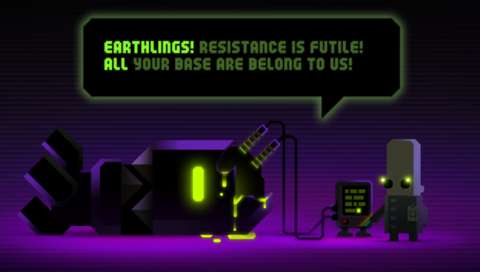
MISCELLANEOUS MENTIONS:
As mentioned earlier already, the how-to-play guide for Revenge of the Titans is found on Puppy Games’ website. Although this is nothing new, this is the first Puppy Games’ title to lack an in-game guide. Having to use a web browser to look at the guide can be immersion-breaking.
On the other hand, to cut Puppy Games some slack, Revenge of the Titans’ gameplay is a lot more complex than the indie developer’s previous titles, so an in-game guide might have been impractical.
CONCLUSION:
Revenge of the Titans is by far, Puppy Games’ most complex title, which is a surprise given its past tendency to lean towards arcade-like gameplay. Nevertheless, its gameplay is such that it is frantic enough that it would surprise anyone who thinks that Puppy Games has lost its touch by creating a title which is supposedly about tower defence. In other words, Revenge of Titans would be quite a pleasant surprise to anyone who had preconceptions about it.
